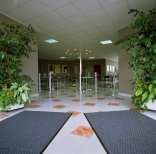Home › magazine › product features › Important matters afoot
Important matters afoot
15th of September 2010Entrance matting provides a visitor with their first impression of an office, supermarket, bank or other facility. But how do matting manufacturers go about maximising the attractiveness of their products while also effectively trapping soiling?
When entering a prestigious international bank or an exclusive store, we are more likely to scan the decor or merchandise than look down at the floor. Yet the plush carpeting or stylish entrance matting provide us with a subliminal message that this is a top grade facility.
Attractive mats that incorporate designs, images or the company’s own logo are becoming increasingly popular. These help to present an upmarket image to customers while reminding them of the company’s branding. But incorporating a logo or other image into a mat will be counterproductive if visitors end up literally wiping their feet on the company’s corporate identity. So how do manufacturers overcome this issue and manage to blend style with functionality?
Milliken’s answer is to have two mats - a functional mat for the visitor’s first footfall followed by a logo mat further inside the building. “Of course the cheapest option is to have one functional mat - but we are not talking about a very big cost compared with the company’s other costs,” said Milliken’s marketing director Patrick Morel.
Milliken mats can be printed with designs or logos using more than 700 colours. Logos can be overprinted on one of three background patterns available in 12 colour combinations. According to Morel, design and functionality are both important to customers when choosing a matting system. “The key is to have an efficient solution so the functionality is of primary concern. But the logo is becoming more important and this is the area where we are seeing most growth.”
He said printing a design on a Milliken mat does not compromise its functionality. “We use the same type of construction for our logo and printed mats as for our plain mats,” he said. “In fact, logo mats usually have a heavier pile.”
Sophisticated printing
According to Morel, printing technology has become so sophisticated that the customer’s choice of design is limited only by their own imagination.
“The technology is way ahead of what people actually want to put on their floor, “ he said. “We can reproduce photos and create fine designs and patterns - it is virtually the same quality as printing.
“But the vast majority of customers want logo mats in three or four colours. People have the technology at their disposal, but the reality is that most of them are still fairly conservative.”
Superior Europe offers design and logo mats under the Notrax brand. Standard designs include patterns such as autumn leaves, pebbles and oriental designs and the company can also reproduce logos using 16 standard colours, though more can be mixed if required.
Marketing co-ordinator Laurence Borrel says performance goes hand in hand with image as far as the company’s customers are concerned. “However, the functionality of the mat remains of key importance,” she added.
She admitted that the company’s logo and printed mats tend to contain less yarn than standard mats. “But they can take a lot of dirt and are laundry washable, so it doesn’t matter.”
According to Borrel, printed matting is becoming more popular and appealing to a widening range of outlets. “Our customers range from hairdressers to huge car retailers and fast food chains,” she said. “Printed mats are a growth market and the recession has not had a negative effect – in fact it is the complete opposite. People are now more concerned about their image.”
Some countries are more open to printed matting than others, she adds. “In the UK, Ireland and Scandinavia people are very switched on to printed matting but in other countries such as France and Spain there is still a lot of work to do.”
UK sales manager of Cobra Europe Chris Stanley explained design and logo mats are consistently popular with its customers. “We receive enquiries on a daily basis for this type of product.” Cobra offers logo and message mats using up to six of 40 available colours. Cobra also offers a Pathmaster logo mat that can be inserted into a recessed well or laid to surface. Customers are asked to submit their own designs and Cobra creates the closest possible colour match.
According to Stanley, incorporating a design will not compromise the effectiveness of a matting system. “In many cases logo mats are used as a secondary mat and therefore play a supporting role in floor protection to a more heavy-duty system.”
He also said the business has not been hit by the recession – quite the contrary if anything. “As spending comes under greater scrutiny many customers have made the decision to buy mats rather than rent, which is cheaper in the long-term. From this we have seen increased demand for logo mats.”
Sales area manager of Kleen-tex Lee Fox also feels the recession may have actually spelt good news for the matting market. “Some companies do well in a recession and can use a logo mat as a statement that they are not just surviving, but prospering,” he said. “Printed mats are not recession-proof, but our logo and design mats have shown a year-on-year growth for the company.”
Kleen-tex offers a standard palette of 44 colours and claims to be able to blend these to recreate any logo. “In total we can offer more than 2,500 colours plus a range of generic designs,” said Fox.
One is not enough
He agrees with Morel that one mat alone is not always the answer to a company’s needs. “Choosing quality products that blend together and appear as a ‘system’ is important,” he said. “This could comprise a heavy-duty scrape and wipe systems for the first few steps, then moisture collection products and textile-top products to wipe and dry the feet and remove the smaller particulate dirt.
“Colour and design can be added to all these options to enhance the image of a company. If matting is ‘thrown down’ without thought then the perception is that the company does not place much emphasis either on its image or on protecting its staff and visitors from slips.”
He says the functionality and image of the matting solution are of equal importance to customers. “Functionality used to be the main decision-driver but with product advances, the fun or fashion element is now an increasingly important factor,” he said. “The main point is not to compromise safety by choosing a pure image product.”
Logo and printed mats are also a growth area for 3M according to building and commercial services division market manager Richard Jones. “The market has shown itself to be surprisingly resilient,” he said. “Even in challenging economic times companies are always looking to enhance their brand and image, while buildings still need effective matting to remain safe and clean.
“The cost of a printed mat is not significantly greater than that of a plain mat - and is certainly far less than the costs of cleaning resulting from insufficient or no matting.”
He agrees with other manufacturers that design and functionality can be combined by using a 'scraper' system to remove and hide the dirt in conjunction with a secondary zone that takes off and conceals moisture and finer dirt.
“Our research shows that the number one need expressed by customers is for a matting system that picks up dirt and absorbs water to prevent tracking it back into a building and reduce the risk of accidents,” he said. “Only when the decision on the type and size of mat has been made correctly should issues such as colour be considered.
“Depending on the image that the customer wishes to create, they can then choose a mat that stands out or is in harmony with its surroundings.”
Colour choice will not generally affect performance but will have an impact on how well dirt is hidden, he said. “Very dark colours and light colours - such as beige and yellow - conceal the least dirt while semi-dark greys and blues are best followed by mid-range browns, reds and oranges. Similarly a random pattern will hide most dirt followed by regular patterns, but with solid colours hiding the least.”
According to Jones, the functionality of a matting system is more important to customers than its design. “The selection of products that lead to dirt and water being tracked into a building to create a dirty and potentially dangerous environment is likely to be far more damaging to a company’s image than, for example, a mat whose colour is not an exact match with its corporate colours.
“The main objective of an entrance matting system is to provide a safe and clean environment for employees, customers and visitors by removing dirt and moisture from shoes. This is the best image a company can provide.”










